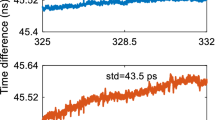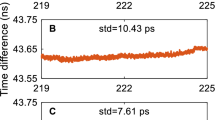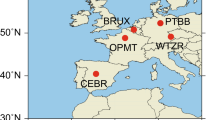Abstract
Precise point positioning (PPP) using dual-frequency GNSS code and phase measurements has been the technique of choice for time and frequency transfer for more than a decade. Several analysis centers providing the satellite orbit and clock products used in PPP now make use of ambiguity resolution methods that preserve the integer nature of the carrier phase ambiguities, thus allowing the development of integer ambiguity PPP techniques (IPPP). By comparison with independent highly stable time transfer techniques not GNSS based, we show that IPPP provides time transfer stability and frequency transfer accuracy with improved long-term performance of order 7 × 10–16/T, where T is the duration in days of continuous phase measurements, thus reaching the sub − 10–16 level after one week of averaging. This method can readily be put into operation between any two locations equipped with such GNSS receivers which have become ubiquitous equipment in scientific institutes. The analysis procedure is described in some detail, summarizing lessons learned from many years of experience and pointing out the necessary checks and the practical points that are needed to ensure that optimal results will be obtained.




Similar content being viewed by others
Data availability
The datasets generated during the current study are available from the author on a reasonable request.
References
Banville S, Geng J, Loyer S, Schaer S, Springer T, Strasser S (2020) On the interoperability of IGS products for precise point positioning. J Geodesy 94:10. https://doi.org/10.1007/s00190-019-01335-w
Delporte J, Mercier F, Laurichesse D, Galy O (2008) GPS carrier-phase time transfer using single-difference integer ambiguity resolution. Int J Navig and Obs. https://doi.org/10.1155/2008/273785
Fujieda M et al (2018) Advanced satellite-based frequency transfer at the 10–16 level. IEEE Trans UFFC 65(6):973–978. https://doi.org/10.1109/TUFFC.2018.2821159
Geng J, Meng X, Dodson AH, Teferle F (2010) Integer ambiguity resolution in precise point positioning: method comparison. J Geod 84:569–581
GRGS Report (2018) Algorithmic documentation of the GINS software https://www5.obs-mip.fr/wp-content-omp/uploads/sites/28/2020/05/GINS_Algo.pdf.
Hachisu H, Nakagawa F, Hanado Y, Ido T (2018) Months-long real-time generation of a time scale based on an optical clock. Sci Rep 8:4243. https://doi.org/10.1038/s41598-018-22423-5
Ido T et al. (2019) Intercontinental comparison of lattice clocks using a broadband VLBI technique. Proc 2019 IEEE International Frequency Control Symposium and European Frequency and Time Forum Orlando
Katsigianni G, Perosanz F, Loyer S, Gupta M (2019a) Galileo millimeter-level kinematic precise point positioning with ambiguity resolution. Earth, Planets Sp 71:76
Katsigianni G, Loyer S, Perosanz F (2019b) PPP and PPP-AR Kinematic Post-Processed Performance of GPS-Only, Galileo-Only and Multi-GNSS. Remote Sens. https://doi.org/10.3390/rs11212477
Leute J, Petit G, Exertier P, Samain E, Rovera D, Uhrich P (2018) High accuracy continuous time transfer with GPS IPPP and T2L2. Proc 2018 Eur Freq Time Forum Tor. https://doi.org/10.1109/EFTF.2018.8409043
Loyer S, Perosanz F, Mercier F, Capdeville H, Marty JC (2012) Zero difference GPS ambiguity resolution at CNES-CLS IGS analysis center. J Geod 86(11):991–1003
Milner WR et al (2019) Demonstration of a timescale based on a stable optical carrier. Phys Rev Lett. https://doi.org/10.1103/PhysRevLett.123.173201
Petit G and Jiang Z (2008) GPS Precise point positioning for TAI computation. Int J Navig Obs Article ID 562878
Petit G, Kanj A, Loyer S, Delporte J, Mercier F, Perosanz F (2015) 1x10-16 frequency transfer by GPS PPP with integer ambiguity resolution. Metrologia 52(2):301–309
Petit G, Leute J, Loyer S, Perosanz F (2017) Sub 10–16 frequency transfer with IPPP: Recent results. Proc. 2017 Joint Conference of the EFTF and IFCS, 784–787
Petit G, Panfilo G (2018) Optimal traceability to the SI second through TAI. Proc 2018 Europ Freq Time Forum Tor. https://doi.org/10.1109/EFTF.2018.8409028
Pizzocaro M et al (2020) Intercontinental comparison of optical atomic clocks via very long baseline interferometry. Nat Phys. https://doi.org/10.1038/s41567-020-01038-6
Samain E et al (2015) Time transfer by laser link: a complete analysis of the uncertainty budget. Metrologia 52:423–432
Shi J, Gao Y (2014) A comparison of three PPP integer ambiguity resolution methods. GPS Solut 18(4):519–528. https://doi.org/10.1007/s10291-013-0348-2
Śliwczyński Ł, Krehlik P, Czubla A, Buczek Ł, Lipiński M (2013) Dissemination of time and RF frequency via a stabilized fibre optic link over a distance of 420 km. Metrologia 50(2):133–145
Śliwczyński Ł, Krehlik P, Kolodziej J, Imlau H, Enders H, Schnatz H, Piester D, Bauch A (2018) Evaluation and development of optical time transfer (OTT) links between PTB and Deutsche Telekom. Proc Europ Freq Time Forum Tor. https://doi.org/10.1109/EFTF.2018.8409023
Acknowledgments
I am indebted to Julia Leute, who worked at the BIPM on IPPP developments for two years until June 2019 with support from the French LABEX Cluster of Excellence FIRST-TF (ANR-10-LABX-48-01). She rendered operational the procedures described in this paper and produced some of the IPPP results used in this study. I also thank my colleague Frédéric Meynadier who helps maintaining the software. The GINS software and the necessary GRG satellite products are provided by CNES-CLS, and I thank more particularly Sylvain Loyer and Félix Perosanz for their extended support. The continuous contribution of time laboratories providing GNSS and other data for their participation to UTC is gratefully acknowledged.
Author information
Authors and Affiliations
Corresponding author
Additional information
Publisher's Note
Springer Nature remains neutral with regard to jurisdictional claims in published maps and institutional affiliations.
Rights and permissions
About this article
Cite this article
Petit, G. Sub-10–16 accuracy GNSS frequency transfer with IPPP. GPS Solut 25, 22 (2021). https://doi.org/10.1007/s10291-020-01062-2
Received:
Accepted:
Published:
DOI: https://doi.org/10.1007/s10291-020-01062-2




